
- MILL HILL
WILDLIFE REPORTS 2014

 |
 |
 |
 |
|
|
|
|
|
Noticeable
summer plants of the upper meadows include Greater
Knapweed, Hardheads (=Lesser Knapweed),
Field
Scabious, Meadow Cranesbill, Alexanders,
Pyramidal
Orchids, Plantains,
Melilots,
Meadow Vetchling, Yarrow,
Eyebrights,
Musk
Thistles, Hounds-tongue*,
Perforate
St. John's Wort*, Great Mullein* and
many others. Herb Robert is
found amongst the scrub.
(*notably
on disturbed ground.)
Some
Indicator Plants of Ancient Downland
 |
 |
 |
 |
|
|
|
|
|
Other
indicators on the lower slopes include Dropwort,
Autumn
Ladies Tresses (upper plateau), Hairy
Violet,
all
of which are rarely found on pastures, restored wildlife meadows or agricultural
downland. Other downland plants that are more likely on the biodiverse
down herbland are Wild Thyme,
Carline
Thistle, Stemless Thistle, Squinancywort,
Fairy
Flax, Small Scabious,
Common
Centaury and
Wild
Basil. There are other more widespread
wild plants like the Mouse-eared Hawkweed,
Hawkbits, Autumnal Hawkbit, Bird's Foot Trefoil, Ground
Ivy, Germander
Speedwell, Field Speedwell, Sweet Violet,
Self-heal
and Yellow Wort.
Wild
Flora and Fauna on Chalk flickr
Adur
Wild Flowers 2009
| OVERVIEW:
A large part (724 acres) of the downs including Mill Hill were presented to the people of Shoreham in 1937. Just over 30 acres still remain as public open land and a Local Nature Reserve. This is divided into about 11 acres of grassland and meadows above the ridge, about 9 acres of scrub, the copse and glades at the northern end, and about half of the prime Chalkhill Blue area of 6.4 acres of herbland remaining. 6 acres has been lost to a Sycamore woodland on the southern slopes. This is low fertility chalkland not suitable for grazing. The top area is effectively a wild meadow and the lower slopes a rabbit warren dominated by prostrate (not the upright form) Horseshoe Vetch, Hippocrepis comosa. |

Horseshoe Vetch |
|||||
| Chalkhill Blues:
Mill
Hill is nationally important because of its population of Chalkhill
Blue Butterflies. Estimates of the numbers
are notoriously inaccurate. In the 1950s
the population was estimated by R. M. Craske
to
be 50,000. This may be an exceptionally good year. I would estimate the
numbers at that time to be nearer 25,000 for Mill Hill only. After the
cattle grazing and thorn incursions the numbers plummeted to the most reliable
estimate in 1960
of 6,000. The new road and Sycamore woodland further denuded the Horseshoe
Vetch, Hippocrepis comosa,
and bare chalk downland to a figure I have estimated at a top figure of
3,000 Chalkhill Blue Butterflies at the turn of the millennium (counted
in 2003). Almost
all these butterflies are now to be found on the six acres of the lower
slopes.
|
 |
|||||
| "Our
family lived at The Mill House, Mill Hill, from around 1933
until about 1967, and every July we saw the
"Butterfly Men" walking past onto the Downs. My father used to tell
us that they were interested in the blue butterflies."
Heather
Clark (née Eager), Ryde, Isle of Wight
|
Nearest
Postcode: BN43 5FH
Grid Ref: TQ 210 074 (upper car park) Geographic Link OS Map Google Earth Map Magic Map of Mill Hill NR Local Nature Reserve Designation Natural England: Local Nature Reserves Multi-Map (Bird's Eye View) |
FEATURE:
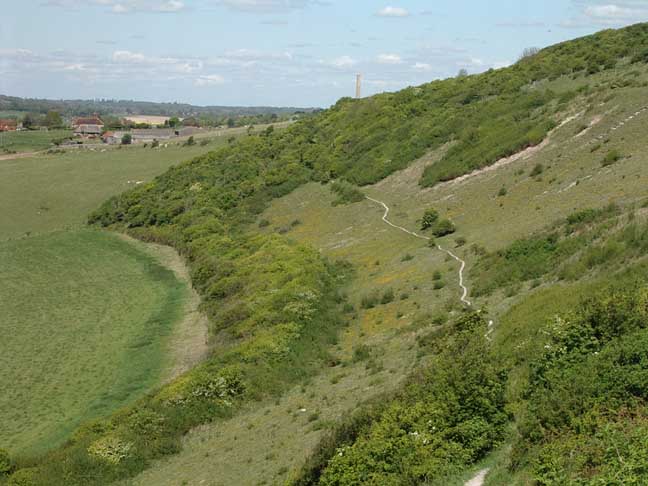
 |
The butterfly lower slopes at Mill Hill are under serious threat by a natural process known as ecological succession where the woody shrubs like Privet, Brambles and Hawthorn invade the herb-rich slopes gradually turning the downs into woodland and eliminating the butterfly larval food plants especially the Horseshoe Vetch, Hippocrepis comosa, on which the Chalkhill Blue Butterflies rely. The remedy is by expert professional removal of the Privet on a regular basis. This job is now being undertaken by volunteers. |

 |
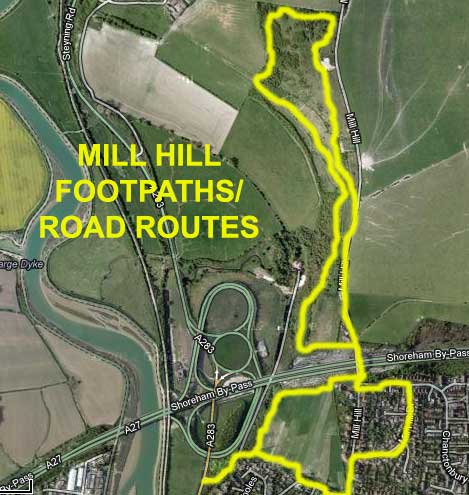 |
OS
Map
Footpaths at Mill Hill WILDLIFE REPORTS |
28 December 2014
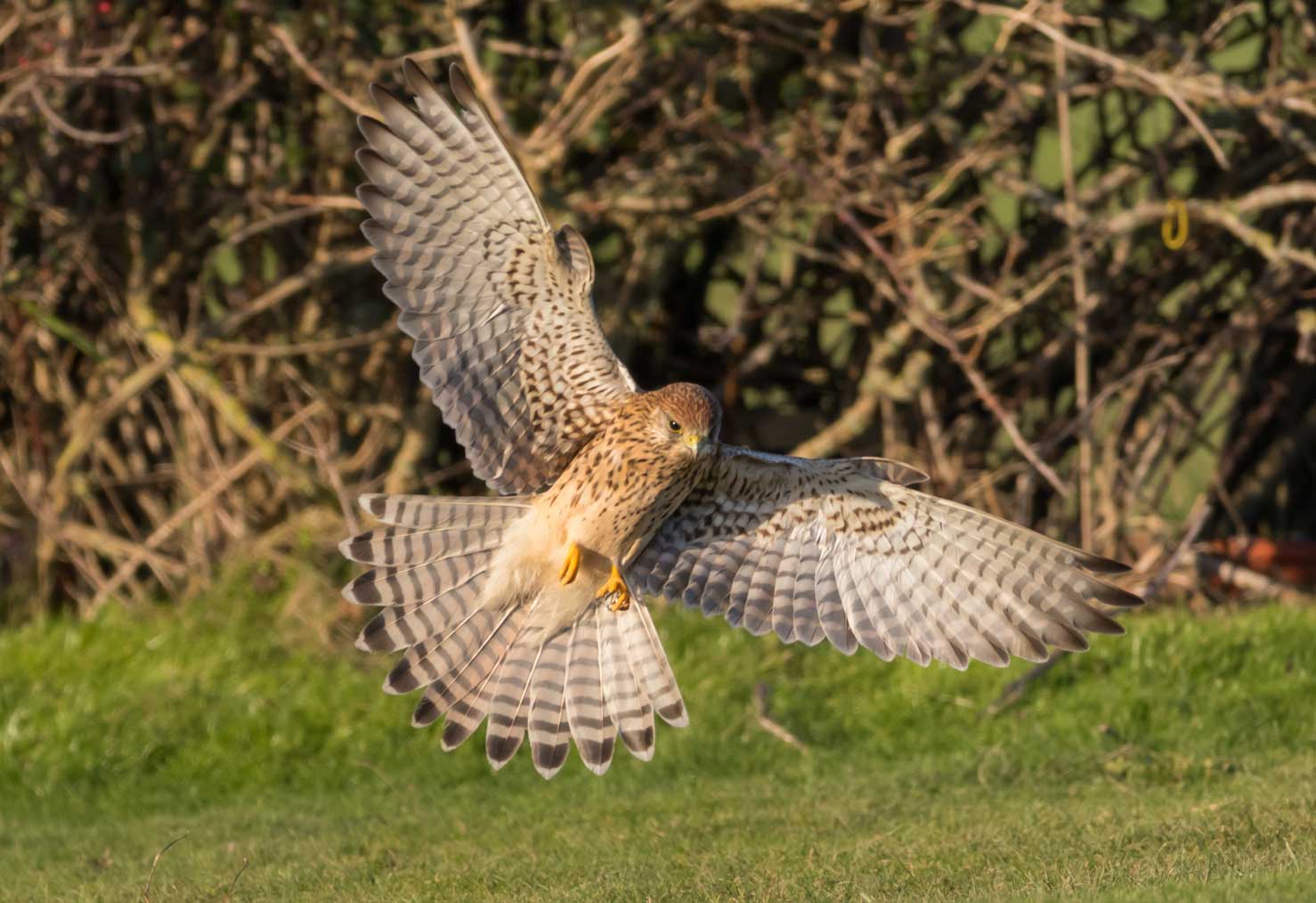 |
 |
Kestrel
Portraits
Photographs
by Etienne Fournier
Please
click on the images for the originals and more photographs
A Kestrel is usually a regular resident over Mill Hill. This superb study looks like a young bird.
19
October 2014
 |
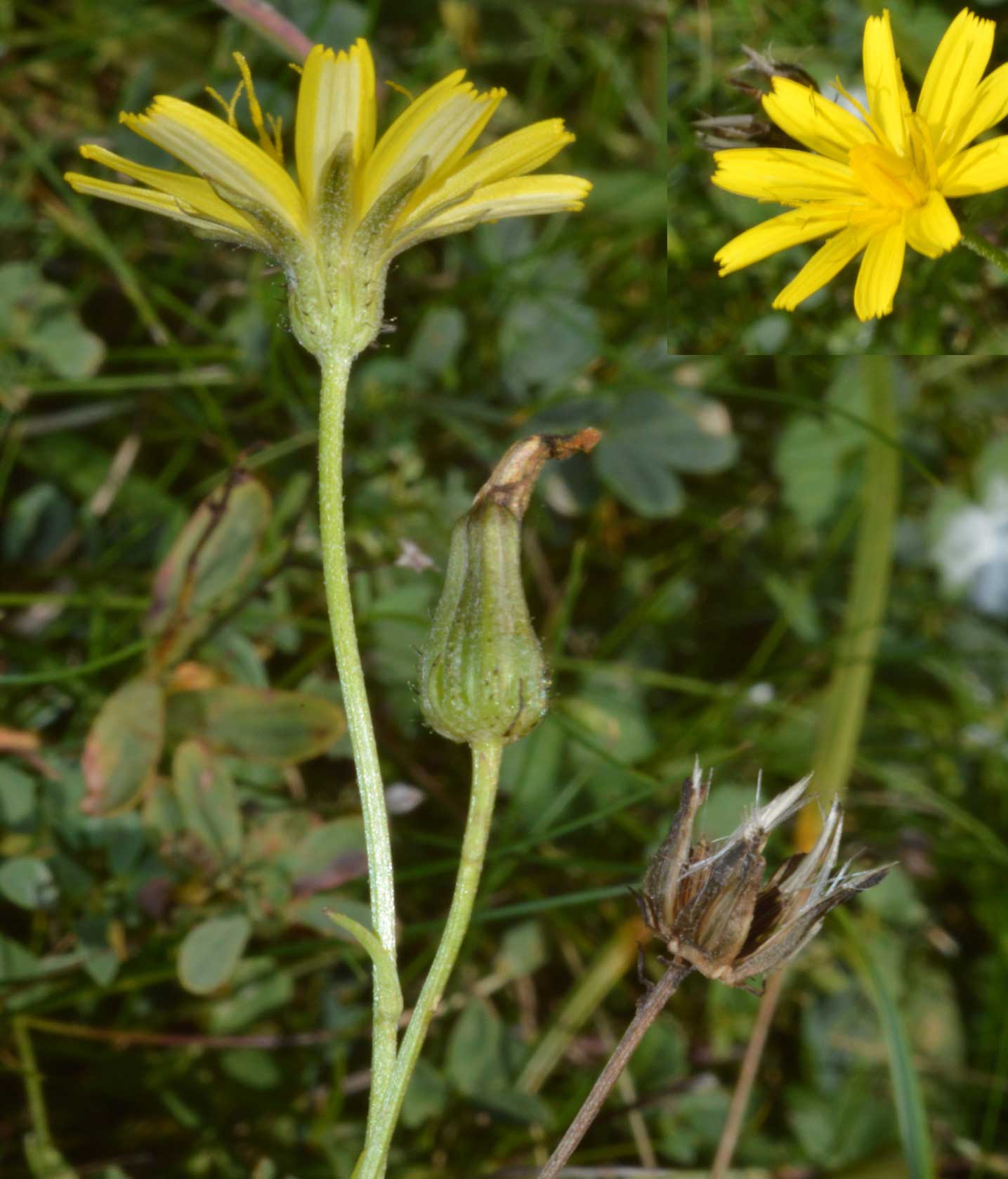 |
 |
|
|
Crepis capillaris |
|
 |
 |
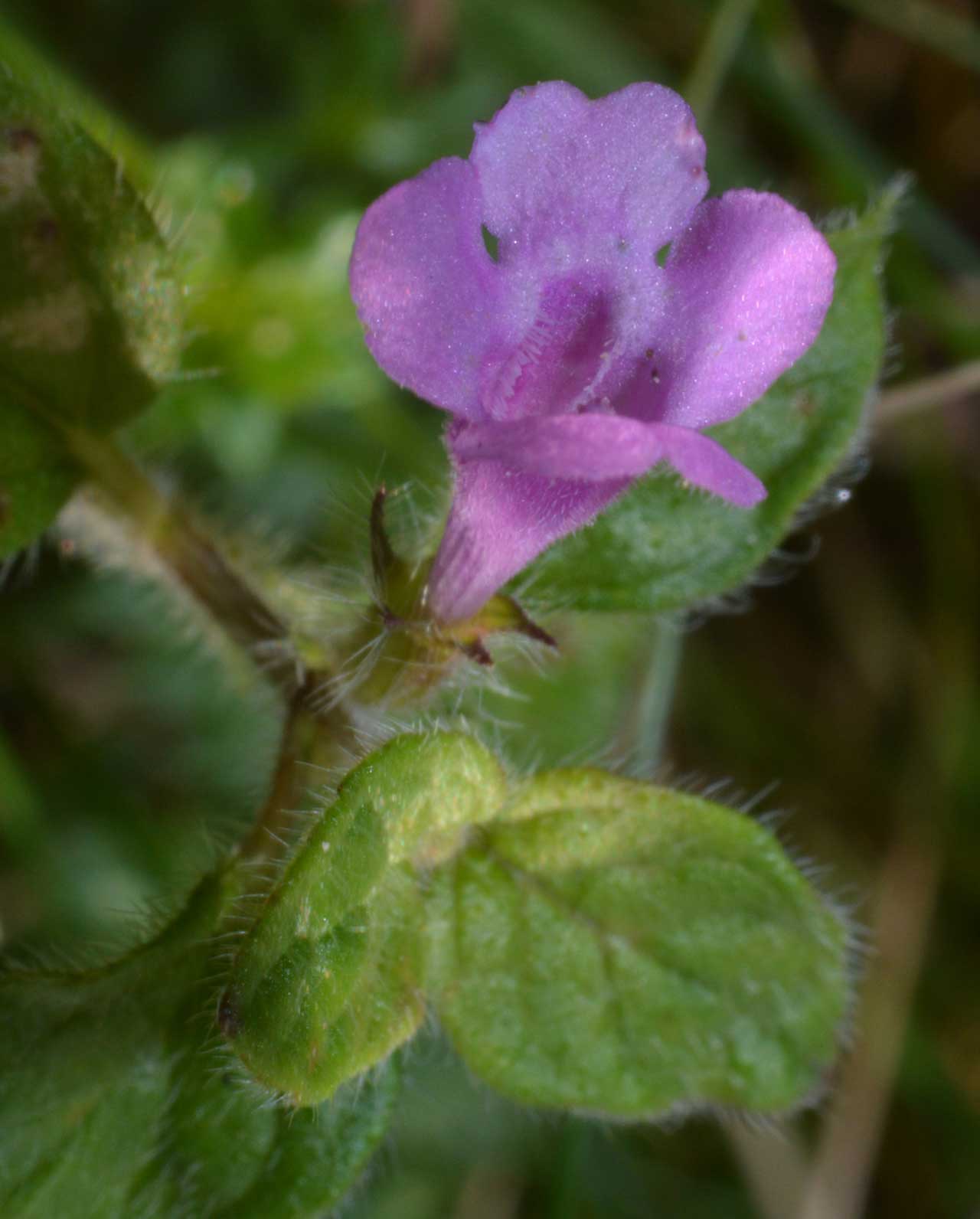 |
 |
|
|
on Carline Thistle |
|
|
No butterflies were present on Mill Hill in a substantial breeze (Force 5). A Kestrel hovered over the top part of the hill to the west of the upper car park. The purpose of the trip was to try out my new camera on still subjects as the only critters vaguely noteworthy were two Common Darters, a bumblebee and a grasshopper over the lower slopes. In circumstances like this I make a mental note of the relatively few wild plants still in flower: Carline Thistle, Rough Hawkbit, Bristly Ox-tongue, one or more Smooth Hawk's-Beard Crepis capillaris, a few diminutive Cat's Ear, one Centaury, a few Great Knapweed, a few Lesser Knapweed (=Hardheads), a few Wild Basil, one Ragwort, one Scarlet Pimpernel, one Creeping Thistle, one Sow Thistle, one Hogweed bush and that was all that were seen on the lower slopes and southern part of Mill Hill Nature Reserve. (The top part of Mill Hill would have added more, but it was too breezy for comfort.) A mushroom was spotted on the verge of Mill Hill Road north of the bridge.
2 October
2014
Just
as I was going to jot down that there were no butterflies
seen on the lower slopes of Mill Hill,
a tatty blue butterfly was disturbed at the northern end after ten minutes
with only Crane-flies
and a few grasshoppers moving about. This
was the first of two male Common Blues
in the late afternoon. Immediately afterwards the first of half a dozen
or more Meadow
Browns
appeared,
including a fine condition male. The most impressive butterfly was a good
condition Wall Brown
that landed briefly on a bare area of chalky earth. Last but not least
was a probable Small Tortoiseshell that
flew off rapidly.
The
lack of butterflies was not surprising given the lack of nectar flowers
except for the very frequent Carline Thistle
in various stages of growth from one grey deadhead from last year to mostly
plants with silver and copper leaves to new growths with green leaves.
There was at least one diminutive Hardhead
and Spear Thistle
seen on the lower slopes with a few Wild
Basil, a few Small
Scabious and the closed flowers of Yellow
Wort. There was one clump of Devil's
Bit Scabious, and one of the the few flowerheads
attracted a small bee, which might have
been a species of Halictus.
A few Hawkbits
were seen.
 |
 |
|
|
|
The
hay meadow below Mill Hill was already harvested for hay and the bales
rolled up. By Buckingham Barn, one bale was being prepared to feed the
cattle
as
they have appeared to have grazed the natural grass from the pasture to
the east.
Adur
Butterfly Report
 16
September 2014
16
September 2014
On
a warm (21.7 °C)
humid afternoon a Kestrel
swooped over the lower slopes. In the field below the hay was being harvested.
I walked amongst the fresh growths of Privet
which were now in berry. Butterflies
were not seen until I reached the Carline
Thistle and the blues were in such a tattered
condition it was not so easy to identify them. Most of them were recognised
as Adonis
Blues
and
there were about fifteen of which about six of them were females.
Some females
attempted to lay eggs despite attention from the males.
Small
Heaths were courting and one pair were
seen mating. There were at least a dozen of them and all were in fine condition.
Meadow
Browns
were
frequently seen as well in about the same numbers. Common
Blues
were
infrequent but there were at least a few and there was at least one Brown
Argus
on
Carline Thistle
and probably more. A much large white butterfly must have been a Large
White. Two Clouded
Yellows fluttered over the lower slopes
without pausing. One was very pale. Nearer the northern end of the lower
slopes of Mill Hill, and sometimes near
the path, there were small cliff edges of exposed soil and these were used
by congregations of the Ivy Bee, Colletes
hederae.
Colletes
species
Adur
Bees
 |
 |
|
|
|
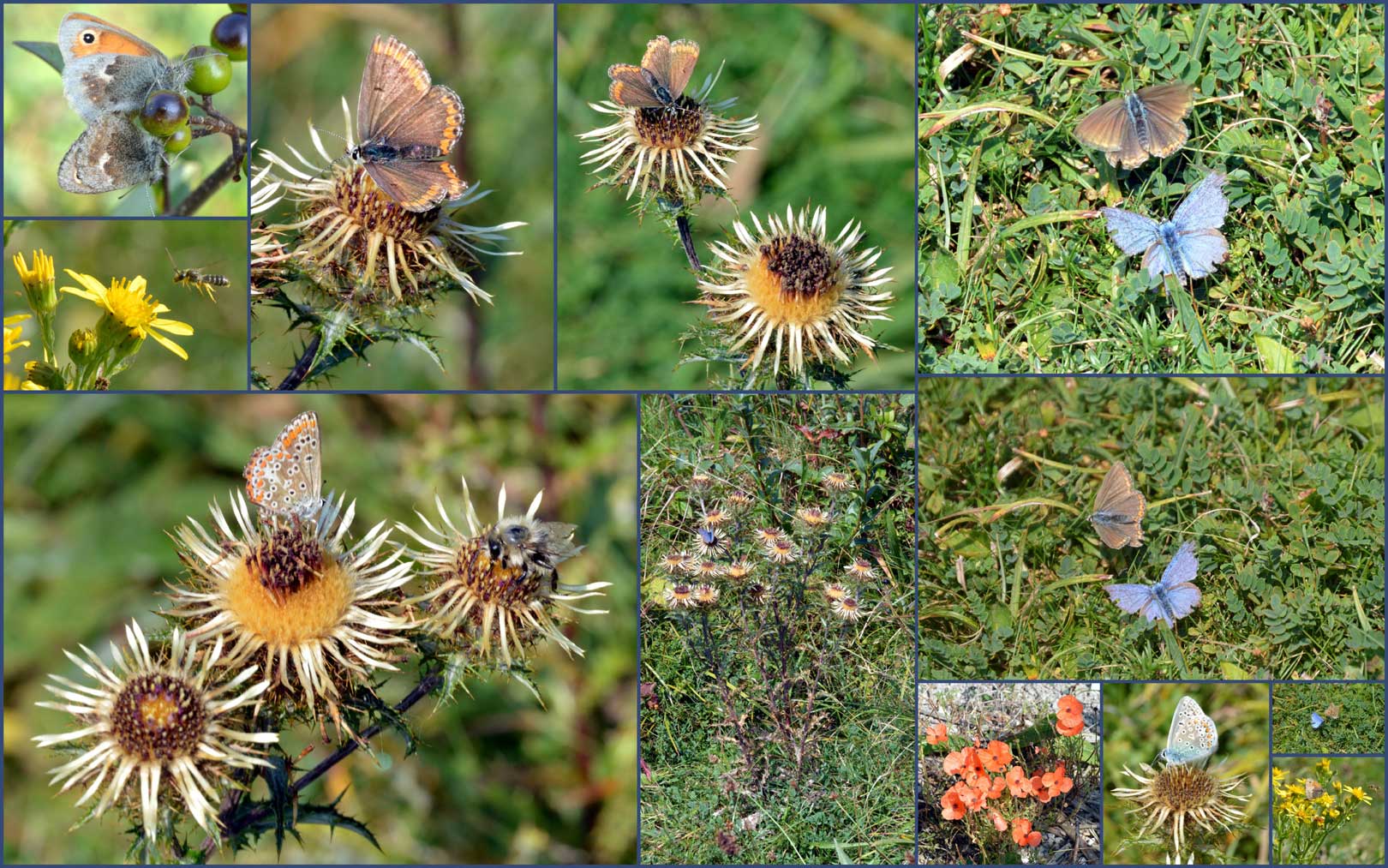
A flock
of about fifteen Rooks
suddenly appeared overhead. Flowering
plants were not much in evidence. Carline
Thistle
showed a few new budding plants and older ones with leaves of green, brown
and silver even on the same plant. There was even a grey
dead plant from last year. I walked through
the scrub and spotted a fresh Red Admiral.
The middle slopes and top meadows were almost bereft of butterflies and
the upper plateau only hosted a few Small
Heaths.
Adur
Butterfly List 2014
28
August 2014
Very
autumnal weather for a week, and then
I trekked up in Mill Hill
on cool afternoon with a noticeable breeze, inimical for butterflies.
I
did manage to spot a probably Large White
over the Dovecote Estate, and a
Speckled
Wood and an active Southern
Hawker (dragonfly)
at the top of Chanctonbury Drive. Mill Hill was breezy (Force
5) and cool with only a Small
Heath seen on the southern upper part
of the hill. Because, it was so uncompromising, I did not work the full
transect
of the lower slopes. I walked the chalky path and ventured down to see
if Devils Bit Scabious
was flowering. It was in small amounts,
overgrown by Privet
at the northern end. Carline Thistle
provided attractive to the frequent butterflies
that were only sent into flight when disturbed. I did not count but estimated
the butterfly numbers at 22+ Meadow
Browns,
23 (18+5) Common
Blues,
18 (15+3) Adonis
Blues,
2 (1+1) Chalkhill
Blues,
and 7+ Small Heaths.
_9686.jpg) |
 |
 |
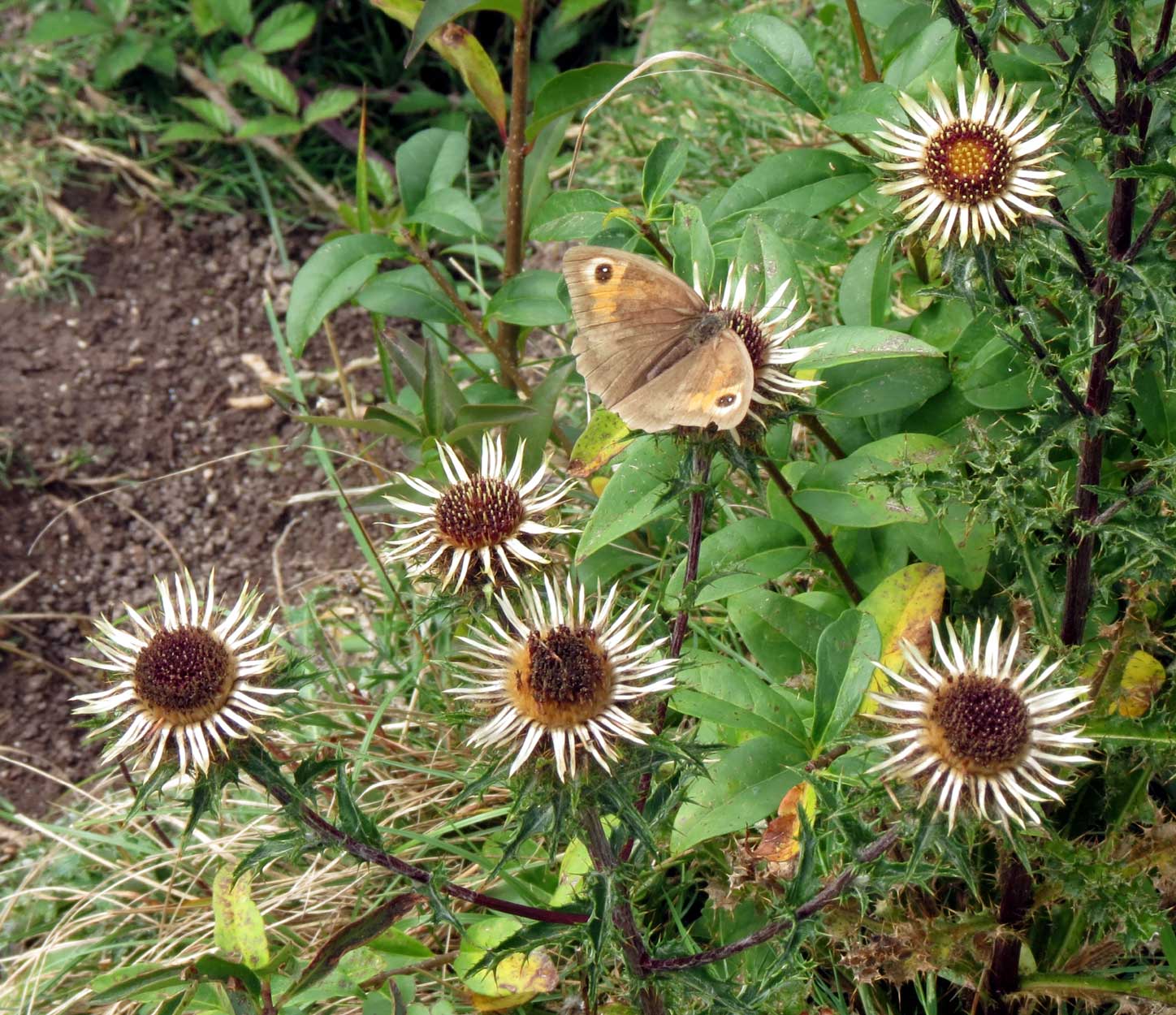 |
|
|
Carline Thistle |
|
Carline Thistle |
At
least one Treble-bar Moth
and one Yellow Shell Moth
were disturbed as well as the tiny pyralid
moths
Pyrausta nigrata and Pyrausta
purpuralis.
Cotoneaster
was seen in a large patch on the lower slopes below the path. I had not
seen a large patch before as usually take a different route.
Adur
Butterfly Report
15
August 2014
I
expected the gales and heavy rain of
the last week to have deprecated the butterflies
and there was not a single one to be seen at the mown open space at Chanctonbury
Drive (north) on the way to Mill Hill. Numbers and variety were severely
diminished on the lower slopes of Mill Hill, almost all of the 10 (7+3)
Chalkhill
Blues
were
in a faded, torn and battered condition.
Adonis
Blues
were
worn and frayed but not in the same state as the Chalkhill
Blues, but only 23 (19+4) were recorded in
the transect acre
on a cloudy day without sun.
The Adonis Blues
included a mating pair. There were a six (4+2) Common
Blues
over
the lower slopes with an estimated 50+ Meadow
Browns
(with
many large females), about a dozen
Small
Heaths, and just the one positive Gatekeeper.
A large vanessid was unidentified, probably a Comma
and
a white butterfly in the distance was most likely a Green-veined
White. Small moths
flitted in the undergrowth including the pyralid
moths
Pyrausta nigrata, Pyrausta
despicata and the colourful Pyrausta
purpuralis.
Three Treble-bar Moths
were disturbed. Many of the butterflies and moths may have been hiding
as after I had completed the transect
the sun came out briefly and there many more Adonis
Blues
and
other butterflies in the same proportions. The distinctive Panorpa
fly
was seen amongst the Privet and Brambles on
the lower slopes of Mill Hill. A Tenthredo
Sawfly was attracted to Wild
Carrot. A Common
Carpet Moth was disturbed in the scrub.
 |
 |
 |
 |
|
|
Carline Thistle |
Bird's Foot Trefoil |
Carline Thistle |
In
a pleasant contrast hundreds of fresh Common
Blue
Butterflies
were
everywhere in the flowery meadows of the middle slopes and upper meadows
of Mill Hill. About three-quarters of these were males,
but included plenty of small females
and a few large pretty females. I checked the female Common
Blues which were clearly most of them, just
in case there was Brown Argus,
but it was only a possible sighting. A Gatekeeper
with a large bite out of its wing landed on Marjoram.
Meadow
Browns
were
frequent and on the top meadow plateau a Small
Heath Butterfly settled. A really worn male
Chalkhill
Blue was seen on the middle
slopes.
Adur
Butterfly Report
| 8
August 2014
A Silver-spotted Skipper was photographed on Mill Hill for the first time. Report
& Image
by Claire Sell
|
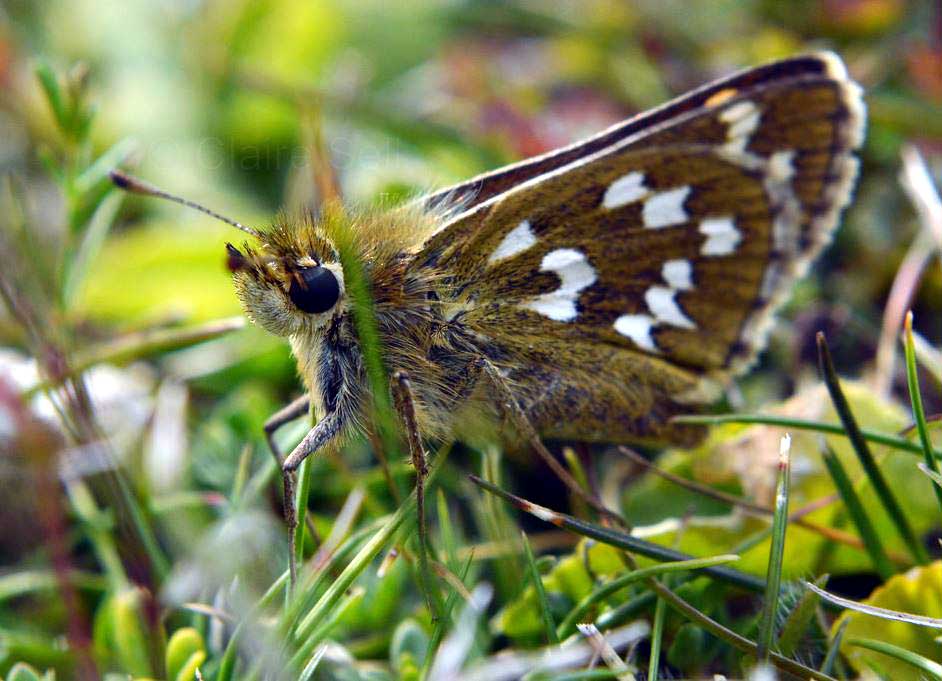 |
| 7
August 2014
Hundreds of butterflies flew over Mill Hill, but they were thinly spread without any hotspots, Meadow Browns everywhere, mainly Common Blues on the top and middle slopes. On the lower slopes 43 (39+4) Chalkhill Blues were counted on the transect acre, with almost as many Common Blues, 25 male Adonis Blues, an estimated 120+ Meadow Browns, 25+ Gatekeepers, occasional Small Heaths, four Marbled Whites, at least one Large White, one Green-veined White, one bright yellow Brimstone, at least four, possibly six Clouded Yellows including one white 'helice' variety, four Wall Browns and faded 6-spotted Burnet Moths and a Treble-bar Moth. On the top part of Mill Hill, there was also two Small Tortoiseshells as well as a Red Admiral, five male Chalkhill Blues and two Adonis Blues seen. A handful of Holly Blue Butterflies were seen on the huge garden hedge north of the bridge. A Hawker dragonfly flew over the hill. |
 |
 |
There was a pyralid moth Pyrausta despicata on the lower slopes of Mill Hill. |
5 August
2014
In
the morning I watched the maiden flight of several Adonis
Blue males at Mill Hill. They perched
on the abundant stems of Yellow Wort
while drying their wings, occasionally discharging meconium
fluid before heading off to patrol the slopes in search of virgin females,
the first few of which are now out. Amongst the many other species present
I was pleased to see a Silver-spotted
Skipper, this was only the second specimen
recorded on the hill. The previous evening my father found a full-grown
Privet
Hawkmoth caterpillar.
1
August 2014
An
exceptional variety of 20 different species
of
butterflies
in an hour on the lower slopes of Mill Hill
made up for a rather dismal number of Chalkhill
Blues for what should be their peak time.
There were hundreds of the restless Chalkhill
Blues but they were thinly spread and the
transect
acre total was only 47. It appeared that many
more were in flight after my count.
Hemp
Agrimony (next to the southern steps)
again proved attractive, and my first Painted
Lady of the year was a persistent visitor
with Red Admirals,
Peacocks
and a Small Tortoiseshell.
Nearby, there were Speckled Woods
and a Holly Blue.
Other butterflies over the lower slopes, in the order of prevalence, were
an estimated 120+ Meadow
Browns,
35+
Gatekeepers,
about 15+ Common
Blues,
about a dozen Small Heaths,
about ten Green-Veined Whites,
about eight Wall Browns all
over the path and some in the long grass, about eight male Adonis
Blues, a few Large
Whites, a few Brimstones,
one or two Marbled Whites,
and one each of Clouded Yellow, Small Skipper
and Dark Green Fritillary.
Later, two pairs of Chalkhill Blues
were seen in mating tussles, which were not completed whilst I was there.
There were also a few 6-spotted Burnet
Moths and a Treble-bar
Moth.
I
curtailed my visit rather rapidly as the sun went behind a cloud and rain
looked imminent.
Adur
Butterfly & Large Moth List 2014
30
July 2014
An
afternoon circular trip over Mill Hill
produced 18 different species of butterfly,
including a restless 69 male Chalkhill
Blues, the first of the second brood Adonis
Blues (2), at least three immigrant Clouded
Yellows, a few vanessids
visiting Hemp Agrimony,
ubiquitous Meadow
Browns,
very
frequent Gatekeepers,
six Wall Browns,
occasional Marbled Whites
and other resident species expected on chalk downs in summer.
A single Hemp Agrimony bush on the southern steps to the lower slopes hosted 3+ Red Admirals, 3+ Small Tortoiseshells, 2+ Peacocks, 2+ Green-Veined Whites, 2+ Meadow Browns and 2+ Gatekeepers all at the same time.
Hemp Agrimony
The full one acre transect on the lower slopes recorded 69 male Chalkhill Blues, the first of the second brood Adonis Blues, at least three immigrant Clouded Yellows, an estimated 150 Meadow Browns, an estimated 60+ Gatekeepers, six Wall Browns, a counted 19+ Common Blues, 5+ Small Heaths, one Brimstone, about a dozen white butterflies including Large Whites, five Marbled Whites, and 6-spotted Burnet Moths. There were more butterflies over the slopes and I eventually found just one female Chalkhill Blue.
The
scrub at the north end of Mill Hill Nature Reserve
added 3+ Speckled Wood Butterflies
and a Holly Blue.
On
the triangle are of the middle slopes a Robber
Fly, Machimus
atricapillus, landed on a mating pair
of Common Blues,
which were frequently seen amongst the Marjoram,
with more Gatekeepers
and Meadow
Browns
and another Wall Brown. The
top meadow added my first Small Skipper
with more Common Blues,
Gatekeepers,
Meadow
Browns,
Green-Veined
Whites and a fresh Small
Tortoiseshell. On the top plateau there were
two male Chalkhill Blues,
Common
Blues
and
Meadow
Browns.
NB:
There
did not seem to be plentiful nectar
flowers
for the restless lower slope butterflies on an overcast day, the Carline
Thistle had only one flower seen, Wild
Basil was not as abundant as usual, Dwarf
Thistle was popular for brief visits as
was the small numbers of Hardheads (Lesser
Knapweed), and Bramble
was visited by Meadow
Browns.
I noted Fleabane on
the southern steps. Ploughman's Spikenard
was
beginning to flower and a few more
Round-headed
Rampion and Autumn
Gentian.
25
July 2014
My
afternoon visit to Mill Hill
was interrupted by a thunderstorm
and rain deluge that drenched me to the skin. I
did not complete the acre transect.
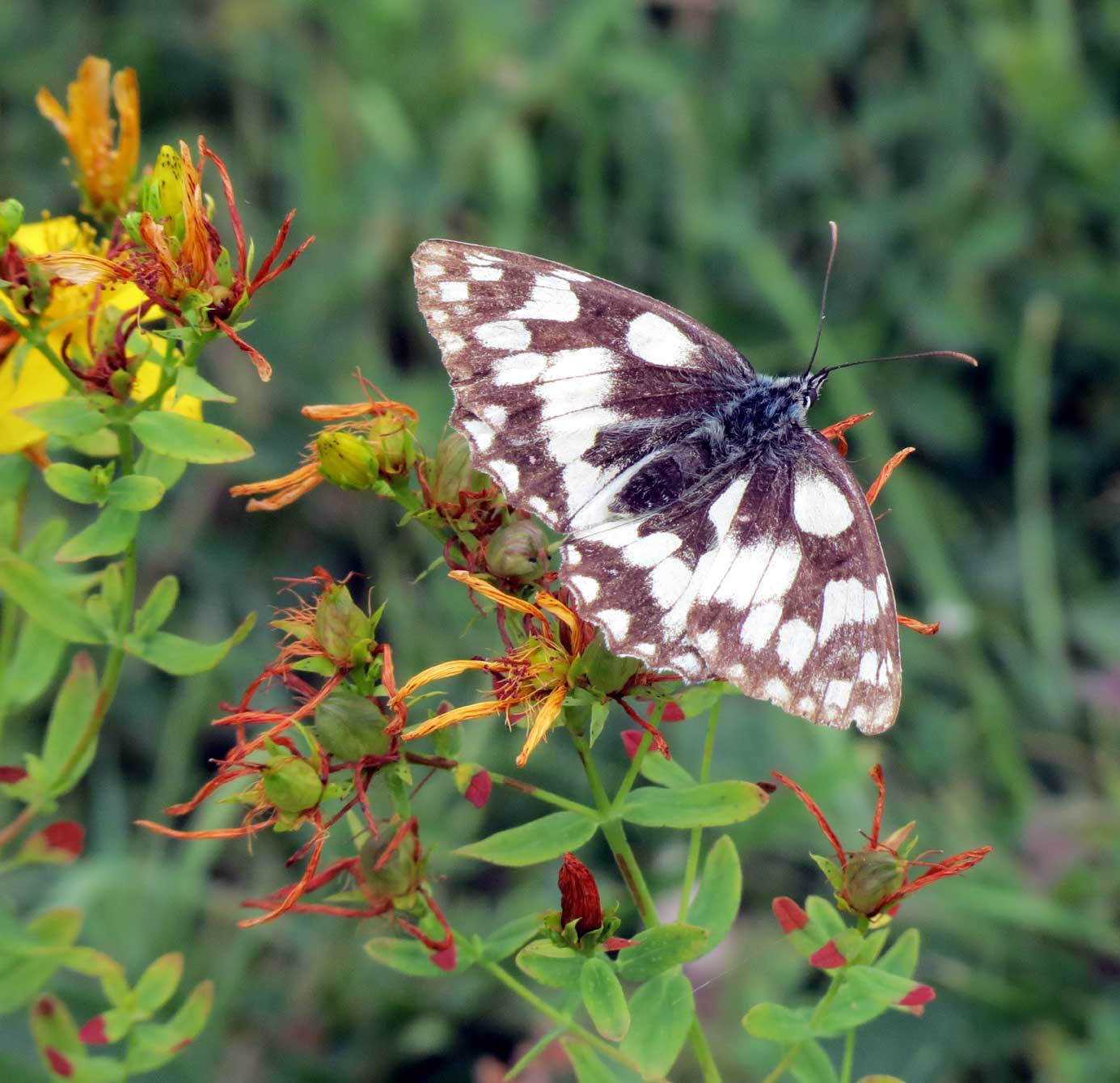 |
 |
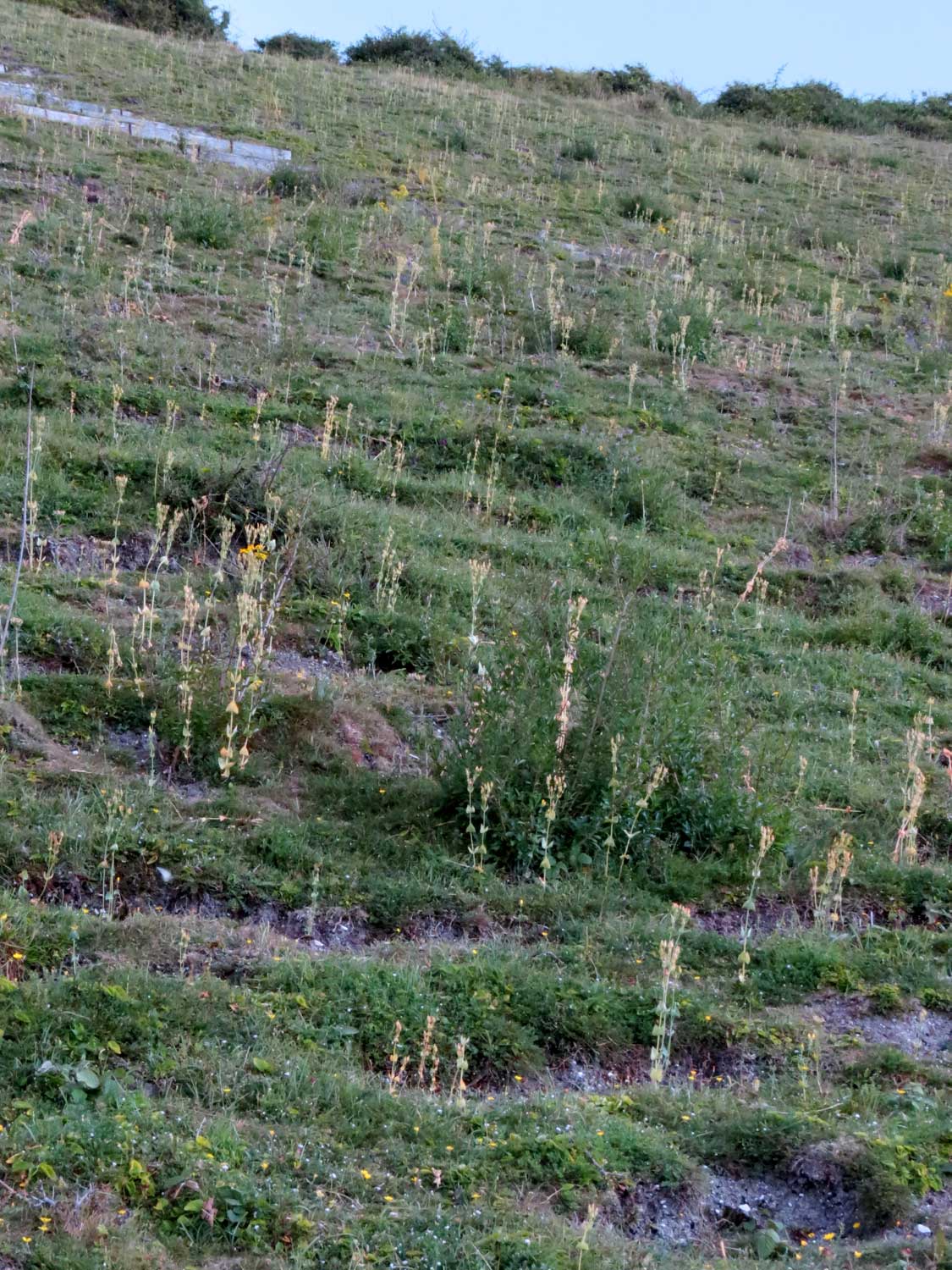 |
|
Perforate St. John's Wort |
|
|
The
southern top part of Mill Hill hosted at least five Small
Skippers, a Wall
Brown, a Red
Admiral, frequent Meadow
Browns,
a Small Tortoiseshell,
a Silver Y Moth and
6-spotted
Burnet Moths.
There
was a bright flash of blue which was possible Adonis
Blue which could not be confirmed and more
likely to have been a Common Blue.
The
lower slopes of Mill Hill, two-thirds of the
acre transect, in 15 minutes, before the rain
deluge, hosted just 15 (12
+ 3) Chalkhill
Blues,
an estimated 60+ Meadow
Browns,
frequent 15+ Gatekeepers,
three Wall Browns,
counted 16 Marbled
Whites, occasional Large
Whites, at least one Small
White, another Small
Tortoiseshell, at least one Common
Blue, three Small
Heaths, and
a few pyralid
micro-moths Pyrausta despicata.
The
first Autumn Gentian
in flower this year was spotted on the
lower slopes. As it was afternoon the Yellow
Wort flowers were closed but these may
be coming ot their end. There were hundreds of this tall narrow plant spread
evenly over the steeper slopes, more than I had seen before. The first
Carline
Thistle was budding and there were still
a few dead grey thistle plants from the previous year around.
21
July 2014
After
the thunder and rain deluges (a weather
front from the south), I was curious to see what life was out on
the downs and about in the humid sunshine
on an overcast muggy afternoon.
 |
 |
 |
|
|
|
|
Large
White Butterflies and at least half a
dozen Speckled
Woods were
seen a top of Chanctonbury Drive on the south-west side of the bridge over
the A27 to Mill
Hill. Butterflies were seen immediately
on entering Mill Hill Nature Reserve from
the south, by the cattle grid and gate. Four species were seen in a few
seconds, occasional Gatekeepers,
frequent
Meadow
Browns.
a
few Marbled Whites and
two skippers,
which turned out to be Small Skippers after
waiting five minutes for them to briefly settle. There was a second flux
of butterfly varieties going down the steps to the lower slopes with the
ubiquitous Gatekeepers
and Meadow
Browns,
more of the plentiful Marbled Whites,
and at least two Red Admirals,
two Small Tortoiseshells,
at least one Peacock Butterfly
and a Brimstone Butterfly.
That was an encouraging ten species
before the lower slopes of Mill Hill, where I immediately spotted a the
first of about a hundred male Chalkhill
Blues, followed almost simultaneously
by the first of the Small Heath Butterflies,
frequent 6-spotted Burnet Moths, Gatekeepers
and Meadow
Browns
everywhere, followed
by two large brown/orange butterflies
which were not identified at first. One conveniently landed nearby and
was identified instantly as a Wall Brown.
This
gave a total species of thirteen in as many minutes.
The other butterfly was more elusive but I tracked it down and identified
it as a Dark Green Fritillary,
my first of the year and a rare occurrence on Mill Hill. I counted 36 male
Chalkhill
Blues in half
of the acre transect. Because of the alarming
over growth of Privet,
at the northern end of the lower slopes, the whole acre transect estimate
(partially counted) was only fifty. However, as I retraced my steps to
go home far more blue butterflies
appeared by about twice as many and they included my first female of the
year. Gatekeepers
and Meadow
Browns
were just as numerous and I estimate there were over 30 Marbled
Whites. I spotted at least three fresh male
Common
Blues, two first of the year restless
patrolling immigrant Clouded Yellows,
more Large Whites,
a few more Brimstones
and frequent 6-spotted Burnet Moths
all on the lower slopes.
My
first of year teneral Common Darter (dragonfly)
landed in front of me. Lindsay Morris
spotted a second brood Dingy Skipper which
I managed to spot. Earlier he had seen a Small
Copper, but this species eluded me. As
I was about to go home I spotted a blue Southern
Hawker patrolling the unruly hedge at
the bottom of the lower slopes. This is a
powerful dragonfly
that regularly catches and consumes butterflies.
A
small Round-headed Rampion
was spotted on the lower slopes. All the Yellow
Wort had their flowers
closed. Hemp Agrimony on
the southern steps attracted two Red Admirals,
a Gatekeeper
and a Peacock Butterfly
all at the same time, and a Brimstone
earlier.: There did not seem all that many flowers
that the restless male Chalkhill Blues
were interested in and they would not stop. They were seen to land briefly
on Self-heal.
The 6-spotted Burnet Moths were
seen almost exclusively on Greater Knapweed.
I
only visited the southern half of Mill Hill
and
the lower slopes.
Adur
Butterflies: First Dates
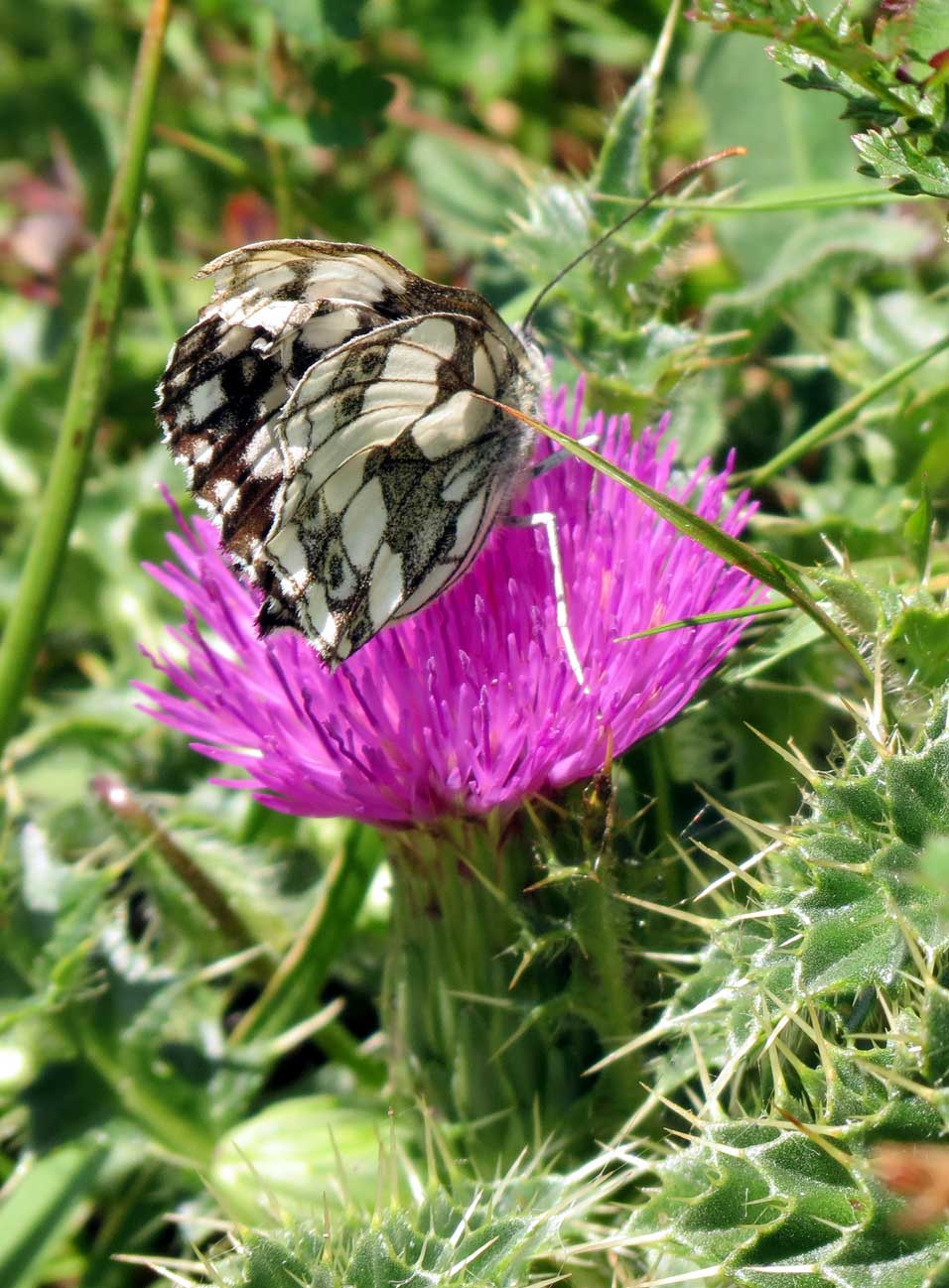 |
 |
 |
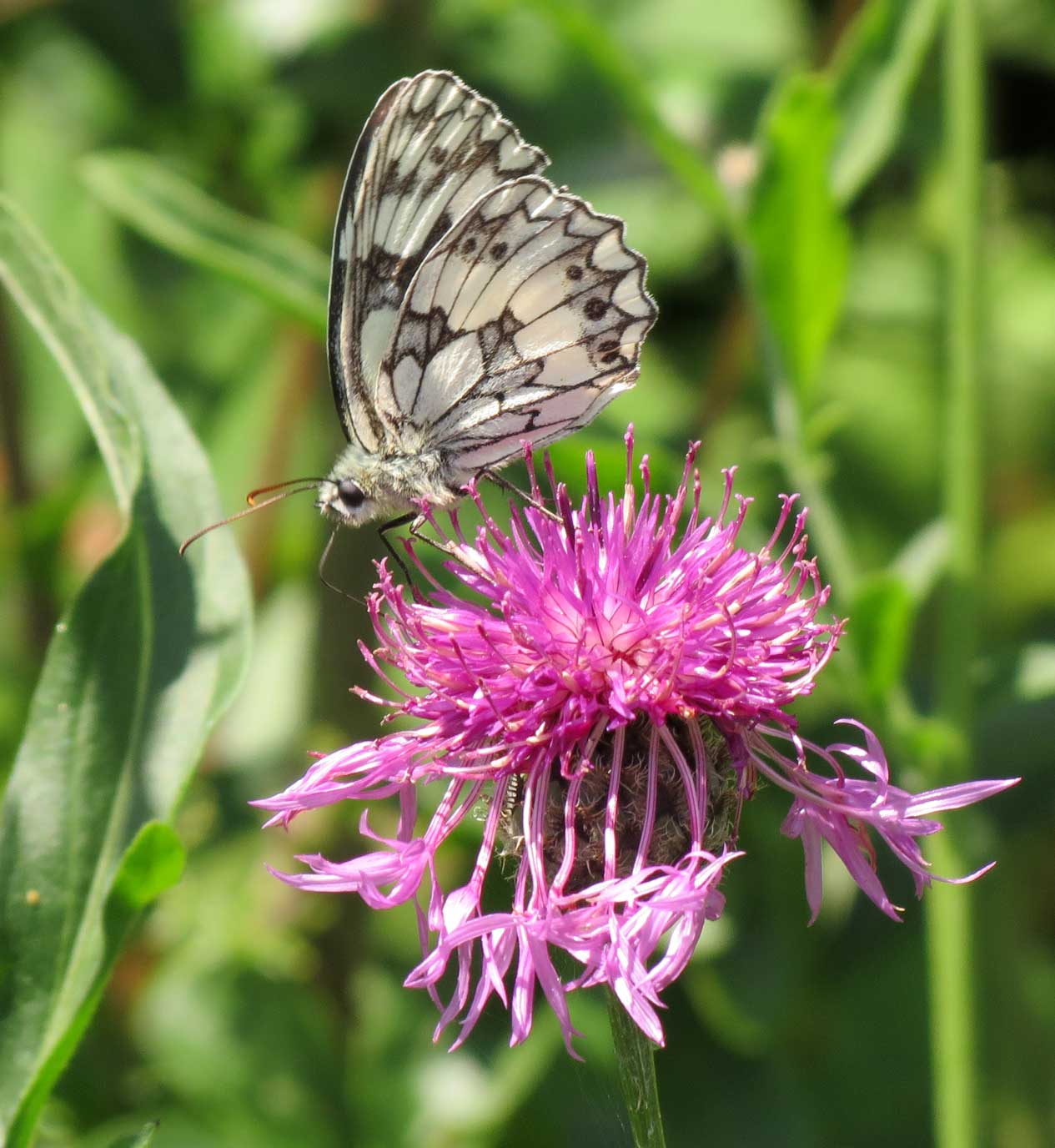 |
|
Stemless Thistle |
|
|
Greater Knapweed |
A cloudy breezy day after overnight rain is not a prime time to visit Mill Hill. The lower slopes were overgrown with Privet and this was noted by a passing visitor. Purple flowers of the Greater Knapweed and Stemless Thistle were the main attraction for the frequent Marbled White Butterflies the most prominent if not the most numerous butterfly on the lower slopes. The one acre transect count recorded 22 Marbled Whites and only five restless male Chalkhill Blues. The most prevalent butterfly were the Gatekeepers in the scrub with an estimate of exceeding fifty on the transect acre with Meadow Browns everywhere with twenty plus per acre with three Small Tortoiseshells, one Small Heath Butterfly and on the southern steps at least one Speckled Wood. About ten 6-spotted Burnet Moths were seen by looking at the Greater Knapweed, and if I looked more diligently, I am sure I would have found many more. Grasshoppers hopped over the lower slopes.
7
July 2014
After
the paucity of butterflies that often occurs
in late June,
there were fresh butterflies on the wing were very frequently seen on the
downs with Marbled Whites
leading the way with at least 71 seen, but there were as many of both Meadow
Browns
and
Gatekeepers
of the ten species
seen in an hour. On the lower slopes of Mill Hill I recorded 33 Marbled
Whites before I nearly stumbled into the first
of eight male Chalkhill Blues.
Other butterflies seen in ones or twos were Comma,
Small Tortoiseshell, Small Heath, Speckled
Wood, Red Admiral
and
a Large White.
Burnet
Moths had just appeared and there was
small pyralid
moth
Pyrausta purpuralis.
Adur
Butterflies: First Dates
 |
 |
 |
 |
|
Self-heal |
|
Greater Knapweed |
Caterpillar |
As we have passed mid-summer, many more chalkhill herbs were beginning to flower, notably Hawkbits, Yellow Wort, Centaury, Greater Knapweed. Musk Thistle, Small Scabious, Field Scabious, Marjoram, but only the first of Stemless Thistle, Wild Basil, Great Mullein and one budding Round-headed Rampion. Autumn Gentian appeared above the short turf but it was not yet flowering.
|
|
 |
 |
|
|
|
|
|
|
Chorthippus brunneus
 |
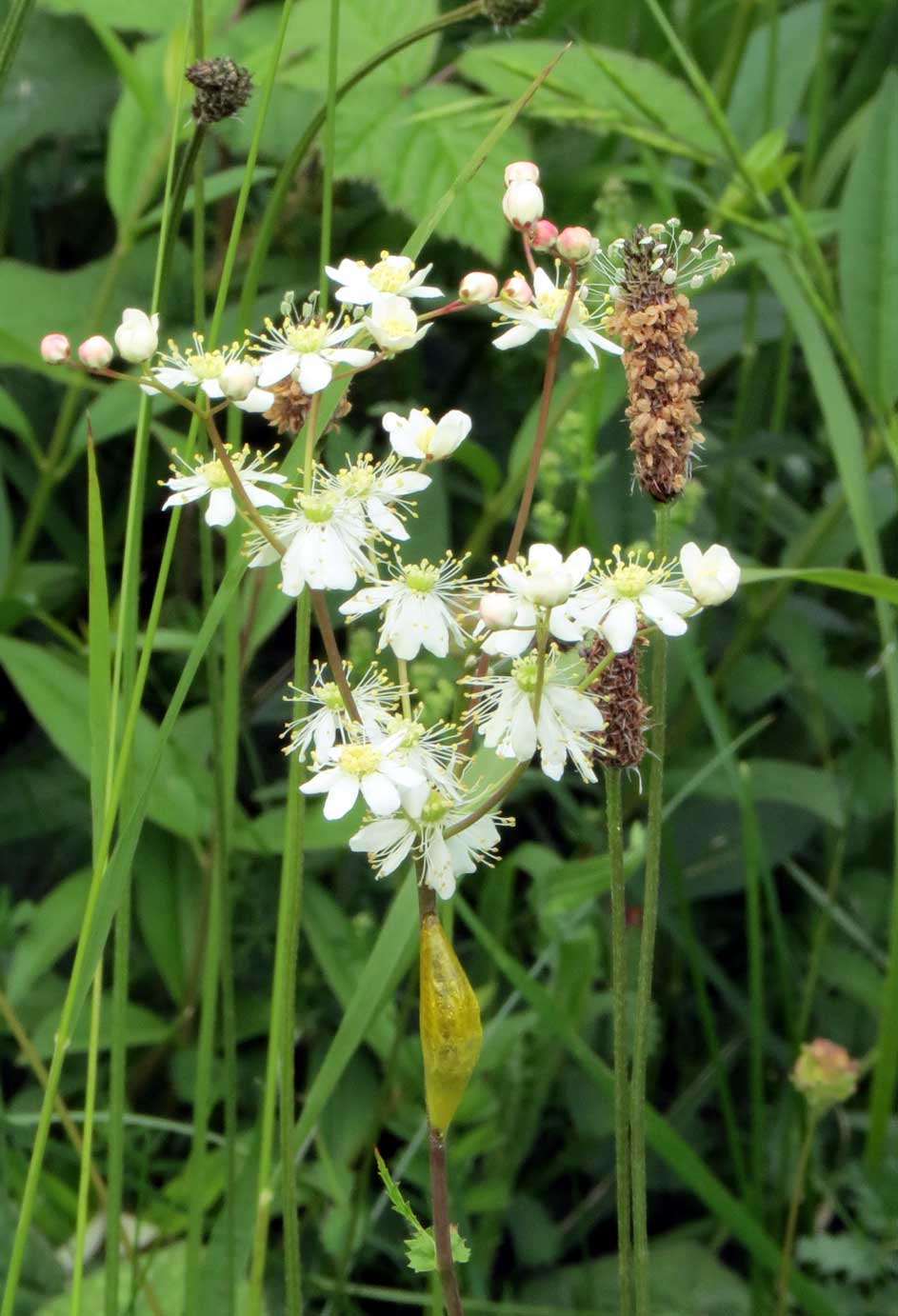 |
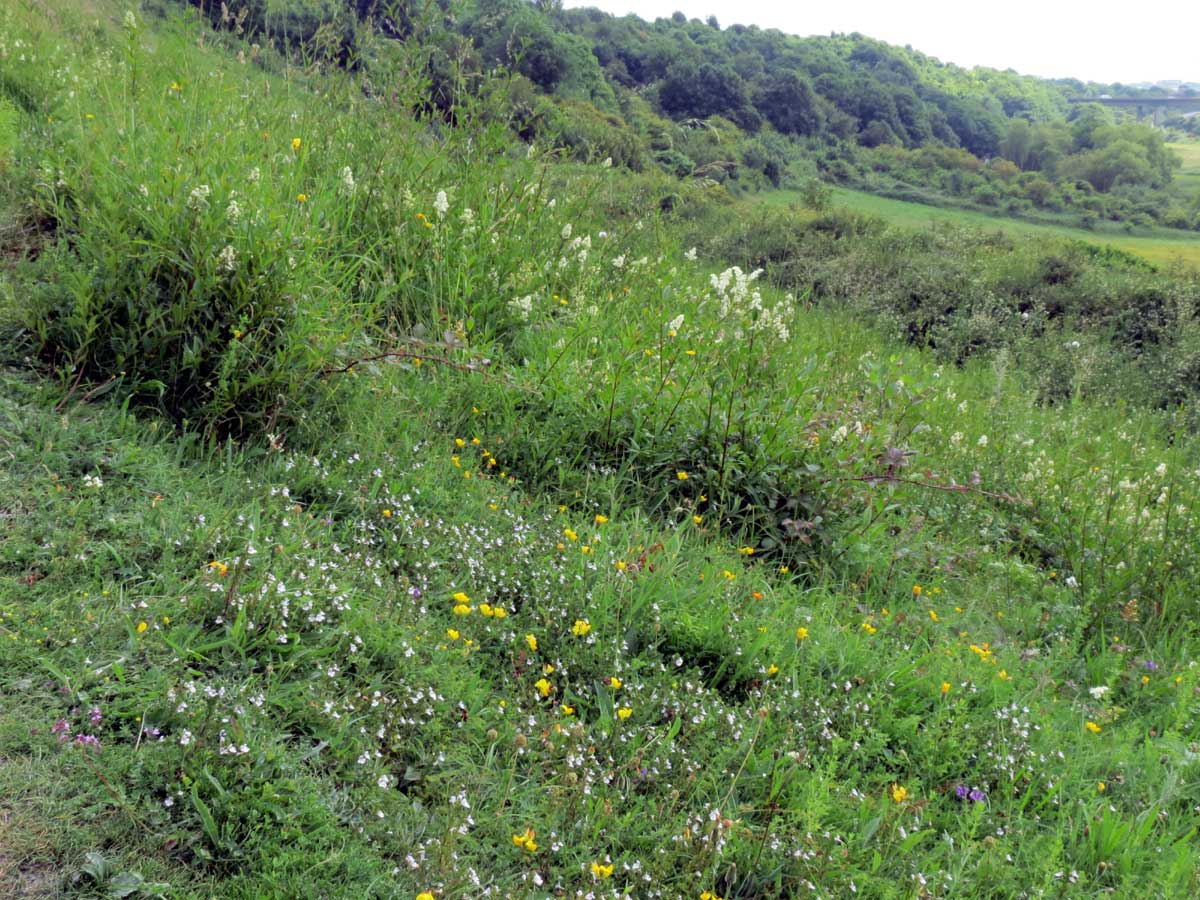 |
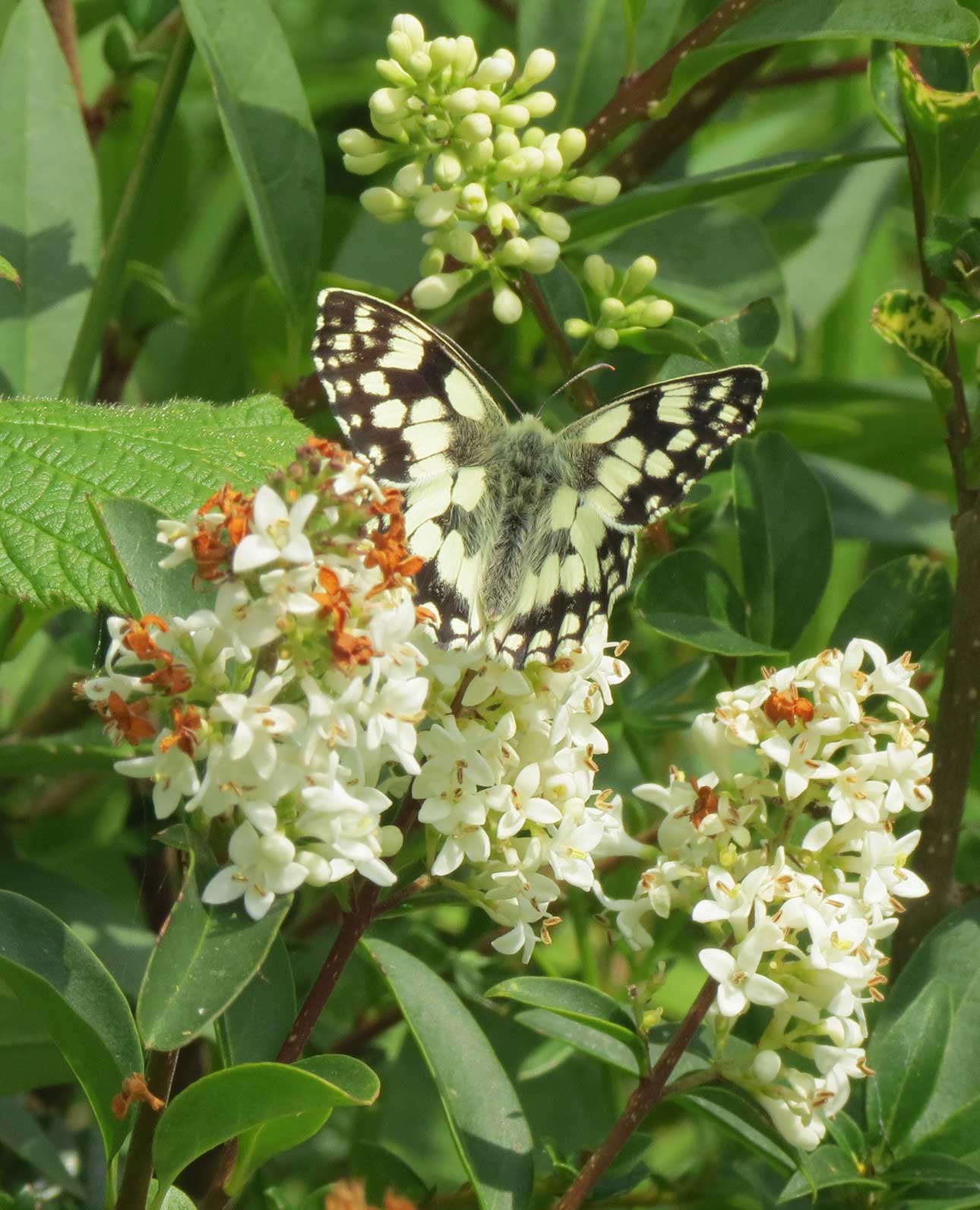 |
|
|
|
|
|
I only
walked less than a half transect
because as soon as I reached the half-way point I was inundated with Marbled
Whites rising from the long grass as I disturbed
them. The was also two worn Common
Blues.
My spell on Mill Hill was much briefer than normal and I departed in less
than an hour.
Adur
Butterflies: First Dates
Adur
Butterfly Report
9 June
2014
On
the lower slopes of Mill Hill, I spotted
my first Large Skipper
and first Meadow Brown Butterfly
of the year. The beginning of June
is often devoid of butterflies
and apart from a dozen Brimstones,
about eight Common Blues
on the lower slopes, half a dozen Small
Heaths and that was the lot seen
around midday. On the middle slopes there was another very white Brimstone
and my second Meadow Brown,
and on the top of hill another Common Blue.
South of the Reservoir I spotted my first two Cinnabar
Moths of the year. There were no Adonis
Blues seen.
_3686.jpg) |
 |
 |
 |
|
|
|
|
|
The
bulk of the Horseshoe Vetch, Hippocrepis
comosa, had disappeared but there
were still isolated flowers as well
as a frequent Dog Violets. Privet,
Dogwood, Wild
Thyme, Yellow
Wort and
Dropwort
were
flowering. The first two are invasive of the butterfly sites. I also noted
a solitary Self-heal
in the short vegetation. Bladder Campion
and White Campion were
easily spottedon the middle and upper slopes respectively.
Adur
Butterflies: First Dates
25
May 2014
Even
allowing that I missed a week through rainfall during the week and missed
the peak flowering, the swathes of Horseshoe
Vetch, Hippocrepis comosa,
on the lower slopes of Mill Hill, were very disappointing and only a mere
fraction (say 20%) of their luxurious best in good years and not even half
as good as bad years.
 |
 |
 |
 |
|
|
|
|
|
It
was breezy and cloudy and far from ideal afternoon for butterflies.
In the transect acre
I recorded one Red Admiral,
21 (15 +6)
Adonis
Blues,
at least one and probably a pair of Common
Blues,
about nine Brimstone Butterflies of
both genders, my first Small Heath
of the year, and one Green Hairstreak landed on a Horseshoe
Vetch flower. A Small
Purple-barred Moth Phytometra
viridaria was seen amongst the short vegetation. As I returned
by the pathway the actual number of Adonis
Blues
seen
in an hour was about forty. I had a sortie over the top part of Mill Hill
but was late in the afternoon by then and there were no positive butterflies,
although there were two possible Dingy Skippers.
On the top plateau and middle slopes, the Horseshoe
Vetch was less than optimum. Dog
Violets were still commonly in flower.
The tiny Fairy Flax
was now flowering and the first signs of Dropwort
was apparent with an occasional plant in flower.
Adur
Butterflies: First Dates
15
May 2014
Yellow
swathes of Horseshoe Vetch, Hippocrepis
comosa, were all over the lower slopes
of Mill Hill, especially the steeper slopes. The expanse was far from its
peak and in each continuing year the flowers
seem to be less and the Privet
much greater. After the torrential rain
of the previous two days, the butterfly population
seem to have been less than normal. The first butterfly spotted was a male
Common
Blue in amongst the Tor
Grass, followed by a restless Peacock.
The first of nine (three in transect acre) Brimstone
Butterflies patrolled the straggly hedgerow
with plentiful Hawthorn
in flower. In the early afternoon the first of 16 male Adonis
Blues (9 on transect) fluttered around
in the weak sunshine.
 |
 |
 |
 |
|
|
|
|
|
Single Dingy Skippers advertised their presence but they did seem inclined to rest for more than a few seconds. About a dozen were spotted (8 on transect). I was surprised to notice a Green Hairstreak on the short sward flora landing on a Milkwort. On the steeper part of the lower slopes, I noted an an extremely worn Small Tortoiseshell. The micro-moth Vine Moth, Eupoecilia ambiguella, was spotted on the lower slopes of Mill Hill.
 |
 |
On
the cropped pastures of New Erringham (immediately to the east of Mill
Hill) a Red Fox
was spotted digging at the turf and then spotted trotting away with a slight
limp as a handful of Rabbits
scuttled into cover.
 |
 |
 |
 |
|
|
|
|
|
On
a hazy slightly humid day, I was surprised by the fluttering of a pale
blue
butterfly. When it settled on the abundant
Horseshoe
Vetch, Hippocrepis comosa,
on the lower slopes of Mill Hill, I was able to identify it as my first
male
Common Blue
of the year. Less than a minute later another blue butterfly appeared at
the northern end of the lower slopes and this settled as well and I could
see it was my first male Adonis Blue
of the year. Later I was to spot a female Common
Blue and another male Adonis
Blue. Other butterflies were only occasionally
seen with about eight Dingy Skippers,
four Brimstones,
at least one Small White
and a Wall Brown
on the lower part of Mill Hill. A Long-tailed
Tit was notable over a clump of thorn
and it may have a nest nearby. Hawthorn
was
in blossom. Dog
Violets were still in flower but there
were coming to their end. A new violet
had appeared with blunt sepals and a purple spur: a few were in flower
and others were just budding. The leaves were plain and without hairs.
As Sweet Violets
had ceased, these were not thought to be them. They could either be a hybrid,
an accidentally introduced cultivated stock or may be Hairy
Violets?
The
records show this was my earliest ever record for a Common
Blue. These were probably the first records
in England of the Adonis Blue
for this year.
Adur
Butterflies: First Dates
Butterfly
Report
30
April 2014
My
transect at Mill Hill
recorded 3 Green Hairstreaks,
12 Dingy Skippers
and one each of Grizzled Skipper,
Orange-tip,
Peacock
and Brimstone.
I twice saw an orange butterfly rush by which did not look like a Comma.
(NB: Probably a Wall Brown AH)
 |
 |
 |
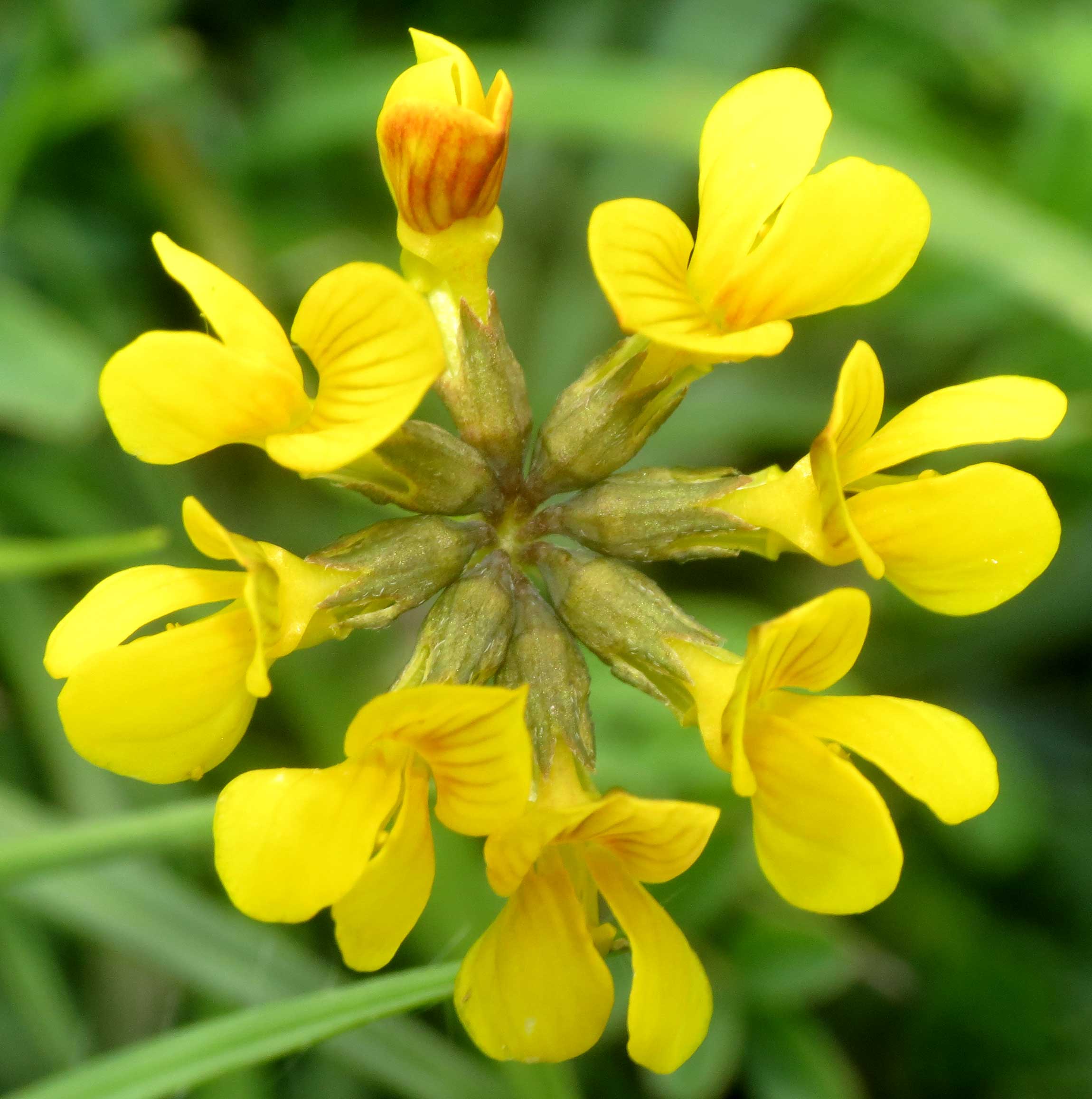 |
|
|
|
|
|
The
lower slopes were more sheltered but it was too cold for butterflies
and the only species actively fluttering around was a Small
White. I did manage to disturb a few butterflies
which were quickly blown about in the breeze. There were at least a dozen
Dingy
Skippers, at least three Grizzled
Skippers, one Wall
Brown and a Peacock.
A Small Purple-barred Moth Phytometra
viridaria was seen amongst the short vegetation, with three Pyrausta
nigrata pyralid
moths
and my first
Treble-bar Moth of
the year.
Horseshoe
Vetch, Hippocrepis comosa,
were
showing but they had only just started flowering
and there was scarcely any more flowers than four days
earlier.
I
spotted a micro-moth
Violet Cosmet Moth, Pancalia
leuwenhoekella, looking tiny on a
Bulbous
Buttercup on the middle slopes.
On
the top of the hill, I felt a chill in the breeze (Force
5), and I hurried across the plateau at
the top where there was only a fresh Wall
Brown blown about.
Adur
Butterfly
& Moth Report
 |
 |
 |
 |
|
|
|
|
|
A walk
around the lower slopes of Mill Hill with
a few rays of sun piercing the clouds produced occasional Brimstone
Butterflies seen instantly, patrolling
the bottom (west side) hedgerow and visiting Cowslips.
The sun went in before I saw any skippers.
There were a handful of both Grizzled Skippers
and Dingy Skippers.
I struggled around the transect (under the handicap of a bad cold) noting
a flighty Wall Brown,
at least one Peacock Butterfly and
a Small Tortoiseshell.
I failed to locate a reported Green Hairstreak. Three small pyralid
moths
were noted. Two were Pyrausta despicata
and
the other one a Pyrausta purpuralis.
A Small Purple-barred Moth Phytometra
viridaria was seen amongst the short vegetation.
The
first hundreds of flowers of Horseshoe
Vetch, Hippocrepis comosa,
were
showing but they had only just started flowering.
Dog
Violets were still in flower but there
were coming to their end.
Adur
Butterfly
Report
Adur
Butterflies: First Dates
17
April 2014
A
Dung
Beetle possibly Aphodius
fimetarius was discovered on Mill
Hill.
16
April 2014
Against
the backdrop of a clear blue sky, a Buzzard
soared over the New Erringham pastures on the other side of the country
road to the east of Mill Hill Nature Reserve.
Rabbits
scampered into cover by the hedgerows next to the road. On the lower slopes
of Mill Hill, the first dozen or flowers
of Horseshoe Vetch,
Hippocrepis
comosa,
were showing along with the
the first flowers of
Milkwort.
Dog
Violets were still in flower but the Sweet
Violets
were down to a occasional battered
remnants.
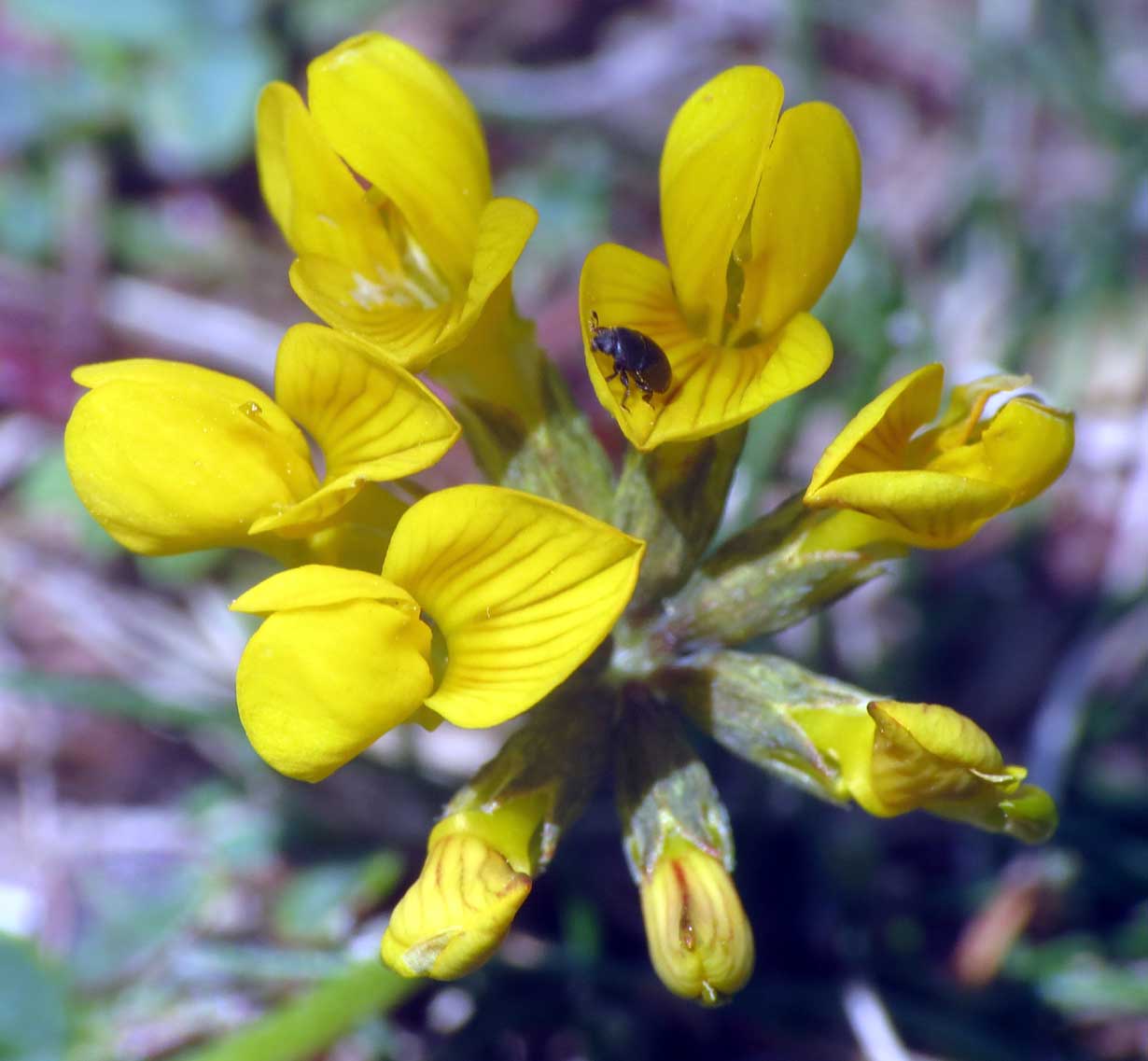 |
 |
 |
 |
|
|
|
|
|
A Peacock
Butterfly, then first of just a few, was
first to show over the lower slopes of Mill Hill, where I spotted my first
skippers
of the year. The first of half a dozen Grizzled
Skippers visited violets,
followed by three pairs of courting Dingy
Skippers. The best discovery was a Green
Hairstreak flitting around the Brambles. Pyralid
moths
were represented by occasional Pyrausta
nigrata
and at least one Pyrausta
purpuralis. A day-flying Small
Purple-barred Moth Phytometra
viridaria was seen amongst the short vegetation.
Adur
Butterfly Report
10
April 2014
A
trip to Mill Hill in the afternoon (3:30 pm)
sunshine was rewarded with the sight of a Stoat
slinking along a footpath, (north of the Reservoir) on the upper part of
the hill, with a young Rabbit
in its mouth. I only got a quick but clear look of about three seconds,
but the Stoat
looked like it had a white stripe down its length, but I think this was
just its white underbelly. The small size of its prey made me think it
was only a young Rabbit.
 |
 |
The
lower slopes were alive with butterflies
but they were mostly about half a dozen energetic Peacock
Butterflies, and about the same number
of Brimstones.
With energy sapped by a virus I did not search in earnest but I could not
find any skippers,
and it was only after over thirty minutes that I spotted my first micro-moth
Violet Cosmet Moth, Pancalia
leuwenhoekella, looking tiny on a
Common
Daisy. It took my eye a little while to
tune in before I was able to recognise at least three Pyrausta
nigrata pyralid
moths.
Only when returning up the steps at
the southern end did I spot my first Small
Tortoiseshell of the day. Common
Bee-flies visited the violets.
Lindsey
Morris reported
both Grizzled Skippers
and Dingy Skippers before
I arrived. David
Potter also saw them and a Green Hairstreak
as well.
Dog
Violets
were abundant over the lower slopes
of Mill Hill with Sweet Violets
reduced
in numbers and battered by the recent rain. No Horseshoe
Vetchflowers
were seen.
Butterfly
Report
Adur
Butterflies: First Dates
1 April
2014
I
completed my first transect of the year at Mill
Hill: Brimstone
6, Comma
1, Peacock
6, Small Tortoiseshell
1. A Pyrausta nigrata pyralid
moth
landed in front of me during the survey.
31
March 2014
 |
 |
 |
|
|
|
|
Dog
Violets were now abundant over the lower
slopes of Mill Hill with Sweet Violets
still
abundant as well. Blackthorn was
flowering.
A single Peacock Butterfly
fluttered over the top op the southern part of Mill Hill.
Adur
Violets
13
March 2014
 |
 |
 |
|
Alopecosa barbipes |
|
|
I took advantage of an hour of weak sunshine before the sea fret (=fog) rolled in. I spotted my first large patches of Lesser Celandine at the north end of Mill Hill Drive. Thousands of Sweet Violets were sprinkled over the lower slopes. The hill was visited by occasional Queen Buff-tailed Bumblebees. On the lower slopes of Mill Hill, I recorded my very first Easter Fox Spider, Alopecosa barbipes. I spotted it crawling over the short vegetation amongst the violets.
 |
 |
 |
|
|
|
|
Three
butterflies
made an appearance on and around Mill Hill. All had awakened from diapause(=hibernation)
and the first one seen was a Red Admiral
(at Chanctonbury Drive, SE of the bridge to Mill Hill) followed by a Small
Tortoiseshell and a Peacock
Butterfly.
Adur
Butterfly List 2014
Mill Hill Wildlife Reports 2015 (Link)
Mill
Hill Wildlife Reports 2013 (Link)
Mill
Hill Wildlife Reports 2012 (Link)
Mill
Hill Wildlife Reports 2011 (Link)
Identification
of Grasses (Link)
Mill
Hill Grasses
17+
SPECIES OF BUTTERFLIES DEPENDENT ON MILL HILL
FOR BREEDING:
(Estimated
numbers for Mill Hill Nature Reserve only
are in brackets)
| Chalkhill
Blue (3000 +)
Adonis Blue (50 -100) Dingy Skipper (75) |
Small
Heath (250)
Wall Brown (12) Meadow Brown (300) |
Marbled White (50)
Gatekeeper (200) Speckled Wood (>50) Green-veined White (2+) |
Common
Blue (>4000+)
Small Blue (5) Brimstone (8) |
Small
Skipper (>50)
Large Skipper (10+) Grizzled Skipper (20) Brown Argus (>30) Green Hairstreak ( a few) |
The other species may breed on Mill Hill, but there main breeding area will be adjoining fields or slightly further away. e.g. Small Blue (included above), Small Copper, Small Tortoiseshell, Green-veined White, Peacock, Ringlet, Small White, Large White, Comma, Holly Blue, Orange Tip. (=10)
The following are immigrants &/or hibernators: Red Admiral, Painted Lady, Clouded Yellow.
The following have not been positively identified (because of ID difficulties): Essex Skipper. This species is now included for a local field on the Adur Levels within 500 metres of Mill Hill.
(=30)
The
following was confirmed only in 2009:
Green
Hairstreak.
(=31)
The next one is no longer
found on Mill Hill but were there in the recent (reduced drastically to
almost extinct by 1948 last record in 1968) past: Dark
Green Fritillary (Records of this butterfly
in 1857, 1938, and 1945 when it was common. Now 2014.)
The next one is no longer
found on Mill Hill but were there in the distant (1947) past: Grayling.
The next one has been recorded
near Mill Hill in the middle distance past: White-letter
Hairstreak
(=34)
The
Silver-spotted
Skipper
does not appear to ever have occurred
on Mill Hill
The
Silver-studded
Blue has never been recorded from Mill Hill
The Short-tailed Blue was recorded as a single immigrant in 1956.
17
August 2009
A
possible (unconfirmed) Brown Hairstreak Butterfly
was
spotted. A confirmed one was spotted nearby.
There
is also the possibility of one of the Fritillary
butterflies.
Aerial
Map
Lower
Adur Levels (MultiMap) including Lancing Clump and Mill Hill
Horseshoe
Vetch,
Hippocrepis comosa
First
Draft of the Article for the Shoreham Society Newsletter